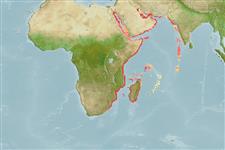Actinopterygii (ray-finned fishes) >
Perciformes (Perch-likes) >
Tripterygiidae (Triplefin blennies) > Tripterygiinae
Etymology: Enneapterygius: Greek, ennea = nine times + Greek, pterygion = little fin (Ref. 45335).
Environment / Climate / Range
Ecology
Marine; demersal; depth range 0 - 12 m (Ref. 12476), usually 0 - 1 m (Ref. 12476). Subtropical, preferred ?
Western Indian Ocean: Pakistan to Natal, South Africa.
Size / Weight / Age
Maturity: Lm ? range ? - ? cm
Max length : 4.0 cm TL male/unsexed; (Ref. 11441)
Dorsal
spines
(total): 14 - 16;
Dorsal
soft rays
(total): 8-10;
Anal
spines: 1;
Anal
soft rays: 17 - 20. Diagnosis: Dorsal fins III + XI-XIII + 8-10 (usually III + XII + 10); anal fin I,17-20 (usually 19); pectoral fin 14: 1-3, 4-6, 6-8 (usually 2, 5, 7). LL, pored scales 13-16, notched scales 21-25, starting at 2 scale rows below the end of the pored series; transverse scales 2/6; nape and abdomen scaleless, first dorsal fin base also without scales. Body depth 4.8-5.2 in SL. Head 3.4-4.0 in SL; eyes large, diameter 3.0-3.7 in head length; orbital cirrus moderate, lobate; supratemporal sensory canal U-shaped and embraces 1st dorsal spine; dentary pores 3+1+3. Male first dorsal fin slightly higher than second; slightly lower in females. Key features are: overall olive green; anal fins black and white barred. Males head black; first dorsal fin, lower pectoral-fin rays and proximal portion of the pelvic-fin rays yellow females (Ref. 57774, 88983).
Female members of the Tripterygiidae have eggs that are hemispherical and covered with numerous sticky threads that anchor them in the algae on the nesting sites (Ref. 240). Larvae are planktonic which occur primarily in shallow, nearshore waters (Ref. 94114).
Life cycle and mating behavior
Maturity | Reproduction | Spawning | Eggs | Fecundity | Larvae
Holleman, W., 1986. Tripterygiidae. p. 755-758. In M.M. Smith and P.C. Heemstra (eds.) Smiths' sea fishes. Springer-Verlag, Berlin. (Ref. 5497)
IUCN Red List Status (Ref. 115185)
CITES (Ref. 94142)
Not Evaluated
Threat to humans
Harmless
Human uses
More information
ReferencesAquacultureAquaculture profileStrainsGeneticsAllele frequenciesHeritabilityDiseasesProcessingMass conversion
Tools
Special reports
Download XML
Internet sources
